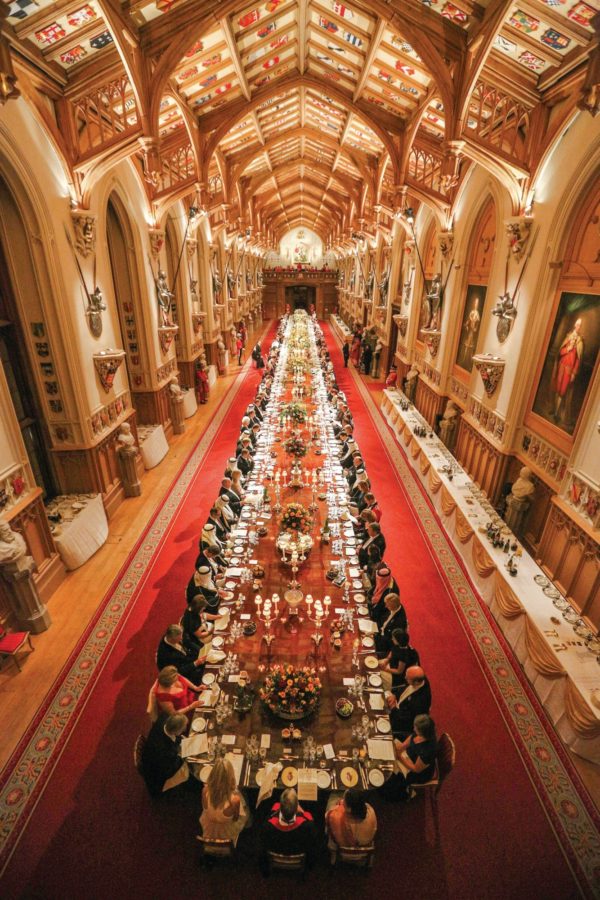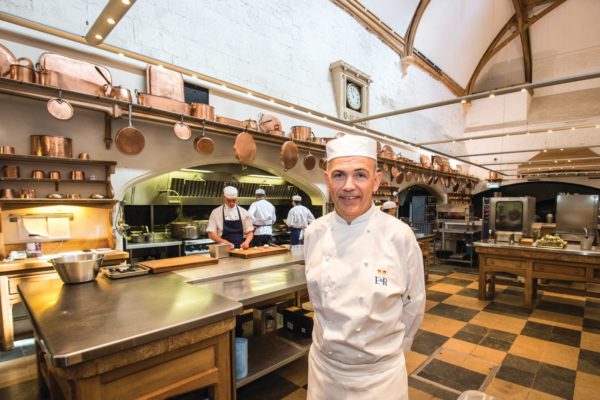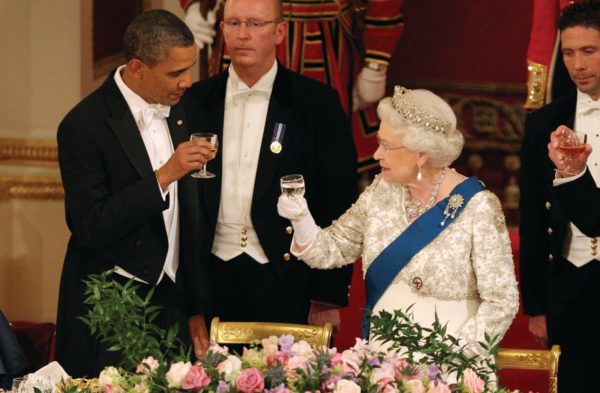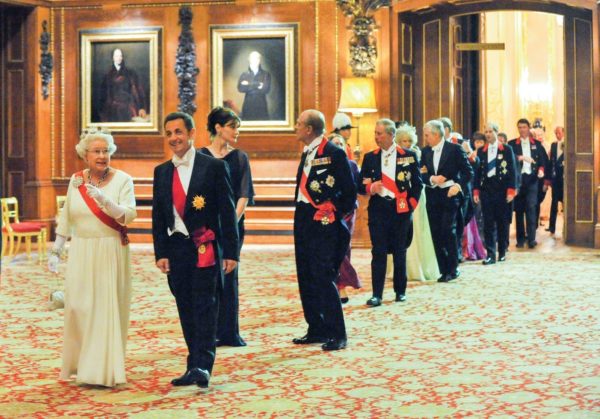A Taste for Tradition
In an extract from the official Platinum Jubilee Pageant Commemorative Album, Tom Parker-Bowles charts celebratory Royal dining across the centuries, from joyful Jubilee luncheons to lavish state banquets
By Tom Parker Bowles
February 13 2023
It is a kitchen like no other, a towering cathedral to classical cuisine, both workhouse and work of art. Just walking into that vast, cool Windsor Castle Great Kitchen takes the breath away with its soaring arched ceilings and fireplaces at each end, fireplaces big enough to roast a whole ox, the spits still very much intact. On the pristine white walls hangs an entire battalion of burnished copper stock pots, pans, jelly moulds and turbot kettles, some imprinted with VR beneath a crown, the insignia of Queen Victoria.
This magnificent kitchen has, for over 750 years, fed kings, queens, emperors and emirs alike, heroes and villains, prime ministers, presidents, and imperial potentates. The sizzling, clanking, hissing and spitting nerve centre of the oldest operating castle on earth is where great boar heads were simmered, capons roasted, stocks clarified, turbots poached, lobsters boiled, artichokes stuffed and sugar spun into the most wondrous of shapes.

"History is everywhere here," says Mark Flanagan, Royal Chef to Her Majesty Queen Elizabeth II. "It's so inspiring to work in such a beautiful place." He is calm and softly spoken, having trained under Albert Roux, Nico Ladenis and Raymond Blanc before joining the household in 2002. "It has to be one of the greatest kitchens in the world." Easily able to fit up to 30 chefs at one time, it is also conveniently close to St George's Hall, home to state banquets, and on Friday 18 May 2012, the Diamond Jubilee luncheon given by The Queen and the Duke of Edinburgh. The menu was short and simple, far removed from the glorious excess of previous jubilee feasts. A tartlet of poached egg with asparagus. Then noisettes of new season Windsor lamb, with carrots, broad beans and spring cabbage. Pudding was a strawberry and vanilla Charlotte. Fresh fruit and cheese finished things off. It was about the edible essence of summer and celebration of fine royal produce, too.
"We very much adhere to the seasons," says Flanagan. The royal estates offer a wonderful natural pantry, and the kitchens make full use of their abundant bounty. Pork, lamb and beef from Windsor; the same from Sandringham. Grouse and red deer, in season, comes from Balmoral, along with pheasant and partridge from Sandringham, and more pheasant from Windsor, too.
Nothing is ever wasted. "When I first came here," says Flanagan, "I had a very restaurant-type approach. Partridge season would end on 1 February." Here, though, they freeze it and use it throughout the year. Many of the vegetables come from an "amazing" kitchen garden at Balmoral. Windsor used to have fruit farms, and some trees still remain, meaning baskets full of apricots, peaches, nectarines, figs and quince. The estates make their own jams and have plenty of honey from the hives at Buckingham Palace. Milk and dairy come from the royal herd in Windsor, eggs from their own flocks, and there is even a cream cheese, made for Her Majesty's exclusive use.
State banquets, held at both Windsor and Buckingham Place, are a subtle form of souffle diplomacy- an event that mixes pageantry, pomp and circumstance with real diplomatic power. Politics may be left to the government, but few doubt the importance of these occasions.
"Her Majesty loves the menu in French," says Flanagan, "and if l get an accent wrong or mix up the masculine and feminine on the menus I send up for her approval, she'll let me know. Her Majesty misses nothing!" He smiles.

Flanagan will offer five different menus to The Queen, but it is not, he admits, "the time for experimentation." He will never serve food that is highly spiced and avoids bivalves, for reasons of safety. As ever, seasonality is everything. "Her Majesty will make the final decision, interject her own suggestions, or remember that so and so really liked that the last time they came. Her memory is incredible. All the menus have her hand on them."
So, how does he know about the individual likes and dislikes of the visiting dignitaries? Flanagan has his own culinary network. The White House Chef, for example. "For any state visit, we get a delegation in advance, who say, 'We need this, we need that.' Keeping up-to-date is nigh on impossible, which is why this chef network is so important."
The Queen always leads the procession in, and no one eats until Her Majesty starts; nor does anyone leave before she has left the room. These events are not so much dinners as theatrical extravaganzas, the long tables glittering with glass and silver, awash in a sea of flowers, the bottom end of the cutlery one thumb's length from the edge of the table, the distance between plates precisely measured. Everything must work like clockwork and timings are exact.
A traffic light system, red and green, hidden in the balustrades of the far balcony of the Buckingham Palace ballroom, is operated by the head steward and tells the footmen when to begin service. When the lights change, one course is taken away, the next brought in. At Windsor, where St George's Hall is close to the kitchen, once ready the finished dishes are transported out in hot trolleys. Most of the dishes are sent up in the small two-man lift. The rest goes up the stairs with the footmen, scurrying up and down in full livery, "like red-coated ants".
The kitchens at Buckingham Palace may lack the soaring grandeur of Windsor but are impressive all the same - large, spacious and immaculately kitted out. The old fireplace and rotisserie remain, the latter operated by a complex system of weights and pulleys. "The iPhone of its time," says Flanagan with a grin.
The room is clean and calm, far removed from its original incarnation in the time of George IV, when raw sewage oozed through the floors and the hot fetid air was thick with charcoal smoke and carbon monoxide, and next door, rubbish was stored alongside the servants' urinal. The whole place reeked.
It was Prince Albert who cleaned up the mess in 1851, moving the kitchen to its present place (near the ballroom, which can seat up to 190 people, but at the other end from the Private Quarters), making it bigger, more sanitary, better ventilated, with hot running water and that state-of-the-art spit. In pre-Covid times, there were 800 mouths to feed daily. Split into staff, events and domestic, this is catering on a vast scale. It is not just the Royal Family and visiting dignitaries who must be fed, but also the army of private secretaries, equerries and ladies-in• waiting, the valets, pages, dressers, maids, policemen and gardeners who make up the royal household.

A jubilee, though, is a special occasion indeed, a cause for national celebration and feasting. It started with the Grand National Jubilee of George III on 25 October 1809, the day on which he entered the 50th year of his reign. Oxen were roasted up and down the country, impaled on a huge spit and secured with a dozen or so large skewers. The hearths were always purpose-built and the beasts donated by a rich squire, landowner or aristocrat, alongside the plum pudding and a good supply of strong ale or cider. England in edible form, John Bull on a plate. The whole country ate, drank and caroused in honour of their king.
According to accounts of the celebrations across the land, the patients of St Bart's Hospital got "excellent roast beef and plum pudding, a pint of porter to each female and a quart to each male patient capable of enjoying it", while there was more roast beef and plum pudding for the children of Christ's Hospital. Deserters in His Majesty's Fleet and Army were granted a free pardon, and illuminations and fireworks lit up the night sky. In Bedford, five "fine fat sheep" were roasted "with a good supply of bread and strong ale, too", while in Cambridgeshire, at Cheveley, the Duchess of Rutland gave a dinner for 900 "surrounding poor" of "old English fare".
Queen Victoria didn't celebrate her Silver Jubilee, being still in mourning for her husband, Prince Albert. But the Golden Jubilee in 1887 was a typically splendid affair. Funded by the Crown (the Whigs and Tories refused to use public funds), there were more ox roasts, tonnes of plum pudding and lakes of ale served to her delighted subjects.
Her Majesty's dinner, held at Windsor the next day, was a rather more substantial affair. It started, as was common, with three soups (turtle, spring and cream of rice), followed by whitebait, stuffed fillets of sole and fried whiting. For the entrées, small vol-au-vents with béchamel, lamb cutlets (a particular favourite of Queen Victoria and never far from the menu) with asparagus, and duck with peas. For the "releves" course, chicken à la financière, haunch of venison and roast beef. Plus roasted quail and baby chicken. And then, just in case anyone was not quite stuffed, green beans, foie gras, scallops with truffles, creamed rice with cherries and some glazed choux buns. Oh, and not forgetting the side table with the usual cold tongue, beef and fowl.

Diamond Jubilee on 22 June, "a never to be forgotten day", in her own words. Queen Victoria sat between Archduke Ferdinand and the Prince of Naples. They devoured two soups (including including Bernoise à l’Impératrice, a chicken consomméin honour of her position as Empress of India), two fish courses, two puddings and, of course, the ubiquitous sideboard with tongue, roast beef, salad, and hot and cold roast fowls. The monarch was 78 and must have been blessed with the constituion of an ox.
These days, things are different, and one towering figure will be deeply missed. "The Duke of Edinburgh was truly interested in food and really knew his stuff," says Flanagan. "A genuine gourmet, but never a snob. It was all about the flavour. And if he enjoyed the taste, it didn't need to be complicated or overly fussy. He was a very unfussy man."
His barbecue skills were legendary, and at Balmoral, he would wander around the fridges, looking to choose the meat, well-hung venison or grouse for that night's grill. "He would then have his own marinade ... He was a hugely talented cook."
Flanagan is unruffled by the pressure of the state banquets and takes huge pride in running a very traditional brigade. Along with the likes of Claridge's and The Ritz, the royal kitchen is one of the few great kitchens left. "You are sometimes cooking in the same pots as Carême. There's nowhere else you have such a sense of history,"
Excerpted from "Her Majesty The Queen: The Official Platinum Jubilee Pageant Commemorative Album" edited by Robert Jobson and Katie Nicholl Contributor, Tom Parker Bowles. Copyright© 2022 by St James's House.
By arrangement with St James's House.
All rights reserved. Order your copy at stjamess.org
WHAT'S ON
Discover what's going on across our famous venues
NYE with FiL Straughan & Mi-Soul DJ's
Canary Wharf
31 December 2025
Welcome 2026 with FiL Straughan and Mi-Soul DJs at Boisdale of Canary Wharf. A night of refined dining, soulful performance and classic R&B, followed by a DJ after-party that runs until 3am. The capital’s definitive setting for a full New Year’s Eve experience.
The Wonder of Stevie
Canary Wharf
2 January 2026
A vibrant celebration of Stevie Wonder’s lifetime of genius, led by mesmeric vocalist Noel McCalla and award-winning saxophonist Derek Nash, performing the landmark songs that shaped soul, funk and Motown across generations.
Cuban All Stars present the Buena Vista
Canary Wharf
7 January 2026
London’s leading Latin musicians, led by Sambroso Noda, bring the spirit of Havana to life with a powerful celebration of Buena Vista Social Club and Cuba’s greatest musical legends. Expect irresistible rhythms, rich percussion and a night of authentic Cuban soul.
DJ Luck & MC Neat
The Hine Bar
29 January 2026
DJ Luck & MC Neat bring the sound of UK Garage to Boisdale of Canary Wharf, with rolling 2-step beats, soulful hooks and lyrical flow that shaped the scene. Hosted by resident DJ Lola So, the night celebrates the groove and spirit of London’s golden era of club culture.
Artful Dodger
The Hine Bar
26 February 2026
The pioneers of UK Garage, Artful Dodger, burst onto the scene in the late ’90s with hits like “Re-Rewind” and “Movin’ Too Fast”. Hosted by Lola So, they return to bring the dancefloor alive with a night of classic House and Garage anthems at Boisdale of Canary Wharf.
Boney M
Canary Wharf
6 March 2026
Founding member Maizie Williams brings the iconic sound of Boney M to Boisdale with a night of pure disco nostalgia, featuring classics like “Rivers of Babylon”, “Daddy Cool” and “Rasputin”. A rare chance to experience one of pop’s most enduring acts up close.
